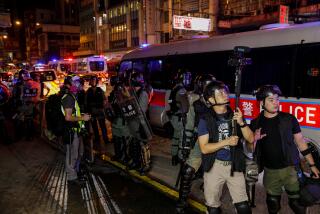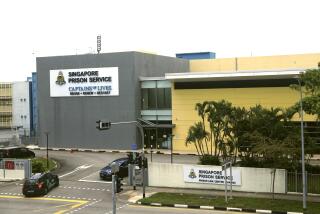Singapore Says Terror Ring Planned Attacks on Americans
- Share via
JAKARTA, Indonesia — A terrorist network broken up in Singapore last month was closely linked to Al Qaeda and had planned to attack U.S. military and business targets in the island state, Singapore’s government said Friday.
The clandestine organization, which called itself Jemaah Islamiah, had been operating in Singapore for years, the government said, and many of its members had traveled to Afghanistan for weapons training in camps run by Osama bin Laden’s Al Qaeda network.
Although some connections to Al Qaeda have turned up in Southeast Asia as authorities investigate the terrorism network in the wake of the Sept. 11 attacks, the arrests in Singapore provide the most comprehensive look yet at an alleged Al Qaeda plot in the region.
A detailed plan to attack U.S. service members traveling by shuttle bus in Singapore was found in Afghanistan on Dec. 14 in the rubble of an Al Qaeda leader’s house, according to a Singaporean government statement.
Also found in Afghanistan was a videotape showing potential targets in Singapore and explaining the possible use of bicycles to deliver explosives. The tape was narrated by Hashim bin Abas, one of the suspects in custody in Singapore, and was broadcast Friday night on Singaporean television.
“These are the same type of boxes which we intend to use,” Bin Abas says as boxes sitting on top of bicycles are shown. “It will not be suspicious to have a motorcycle or bicycle there.”
The alleged leader of one cell was identified as Khalim bin Jaffar, a 39-year-old printer. He also was among the 13 people arrested. All have been ordered held without trial for at least two years under Singapore’s strict Internal Security Act. Another suspected cell member who left Singapore in October was arrested in Afghanistan in November by anti-Taliban Northern Alliance forces.
For the most part, the Jemaah Islamiah cells in Singapore were home-grown. All the alleged members attended Singaporean schools. Six had served in Singapore’s armed forces. Most were quietly recruited through classes on Islam taught by one of the group’s members.
The existence of a terrorist group in the prosperous nation of 4 million came as a shock to many, particularly because Singapore’s government is one of the most authoritarian in the region. Singapore may be best known for banning chewing gum; it also limits free speech and political opposition.
Despite its rigid controls, Singapore would make a good staging area for an attack on U.S. interests. The two countries are close allies. The U.S. military has a significant presence in the country, and many U.S. companies also have offices in Singapore. About 15% of the population is Muslim, providing Islamic militants with a community in which to operate.
In Washington, U.S. officials praised Singapore’s actions. “I think that the government of Singapore has acted with dispatch, and we’re very pleased that they’ve been able to do what they’ve done,” Defense Secretary Donald H. Rumsfeld said at a Pentagon briefing.
Gen. Richard B. Myers, chairman of the Joint Chiefs of Staff, said the videotape seized in Afghanistan was not the first indication of threats against U.S. targets in Singapore.
Group Reportedly Part of Regional Network
It is not clear how police learned of the existence of Jemaah Islamiah. However, authorities say the group is part of a regional network with links to Indonesia, the Philippines and Malaysia. All three are countries where Al Qaeda is reported to be active, and where there are Islamists who favor creating Muslim states.
Singaporean authorities said the overall leader of Jemaah Islamiah is an Indonesian religious teacher who goes by the name of Hambali. Malaysian authorities say he is wanted in that country on charges of heading a terrorist group known as the Kumpulan Militan Malaysia. Singaporean authorities said Hambali is also wanted in Indonesia.
Over the last seven months, authorities in Malaysia have arrested 38 suspected terrorists allegedly connected with the Kumpulan Militan Malaysia.
On Friday, Malaysian Prime Minister Mahathir Mohamad said that about 50 Malaysians were part of organizations linked to Al Qaeda and Bin Laden, including those already arrested.
“What we know is these people admitted they were trained in Afghanistan by the Taliban and by the group of Osama bin Laden,” Mahathir told reporters in Kuala Lumpur, the capital. “As far as we know, their intentions are very bad, namely to create trouble and to try and overthrow the government by terrorist means.”
Singaporean authorities said Jemaah Islamiah had no apparent connection with local Muslim groups. The organization was divided into cells to keep its operations secret, and three cells have been discovered so far.
“The group appeared to have generally kept away from mainstream organizations and their activities,” Singaporean authorities said. “They maintained tight operational secrecy, using code names and code words for communication.”
The oldest of the three cells began looking for targets as early 1997 and conducted surveillance of places in Singapore frequented by Americans, the government said.
U.S. defense officials said the suspected terrorists appeared to want to target American sailors and the 17,000 Americans living in Singapore. In addition to a Navy logistics unit based on the island, U.S. carriers and other vessels stop to be refueled in Singapore at a naval facility built especially for them. The logistics base has a permanent American staff of about 100.
Singaporean authorities said Khalim, the alleged leader of the cell, briefed Al Qaeda leaders on the plan to blow up a bus carrying U.S. military personnel when he went to Afghanistan for training between August 1999 and April 2000. It was for this plan that the video was made.
But for reasons that are unclear, the government said, Al Qaeda leaders chose not to have the cell carry out the plan.
The cell also allegedly developed a plan to attack U.S. Navy vessels off Singapore’s northeastern coast. Police found a map among Khalim’s possessions marking observation posts on shore and a “kill zone” in the water.
Authorities discovered that Khalim had a list of more than 200 U.S. companies in Singapore. Three of them were highlighted as potential targets, authorities said, but they did not identify them.
Surveillance Targeted Air Base and Embassies
The second cell was developing a plan to attack U.S. military planes at Singapore’s Paya Lebar air base, officials said. One member took more than 50 photos of the base--where about 30 U.S. Air Force trainers work--and airplanes there, authorities said.
In September or October, unidentified foreigners using the code names “Sammy” and “Mike” made contact with the cell. Together they conducted surveillance of the U.S. and Israeli embassies, British and Australian government offices and buildings where American companies are based. They also videotaped the locations, officials said.
The foreigners enlisted members of the cell in efforts to acquire 17 tons of ammonium nitrate to make truck bombs, the government said, adding that they apparently had already collected 4 tons in Malaysia. The suspected terrorist cells were broken up before the plan could be carried out.
The third cell was formed after the Sept. 11 attacks on the United States. It began conducting preliminary surveillance of potential targets, including U.S. companies, but stopped when the first arrests were made in early December.
Of the 13 arrested, at least eight are suspected of having received weapons training at Al Qaeda camps in Afghanistan beginning as early as 1991, the government said. The training included how to shoot a Kalashnikov assault rifle, fire a mortar and make bombs.
Two suspects arrested with the 13 others were later released. The two had contributed funds to Muslim separatists in the Philippines but did not belong to Jemaah Islamiah, authorities said.
“Investigations are continuing,” the government said. “Several suspect operations cell members have fled the country and efforts are being made, in cooperation with the authorities of neighboring countries, to locate them.”
*
Times staff writer John Hendren in Washington contributed to this report.
More to Read
Sign up for Essential California
The most important California stories and recommendations in your inbox every morning.
You may occasionally receive promotional content from the Los Angeles Times.













